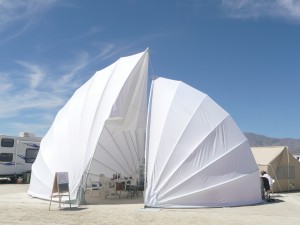
Shade Structure, –noun, It’s hot in the desert. Normal tents become unbearable for human occupation within a few short hours after being reached by direct sunlight. It quickly grows brutally hot; cloud cover is rare and shade on the playa is non-existent — unless participants bring it for themselves.
What a hat does for your head, a shade structure does for your camp. Shade structures range from the simplest rigged tarps to complex, custom built awnings. The geodesic dome, inspired by the work of hippie hero Buckminster Fuller, is a popular shape but innovation abounds.
Shade structures might be so small as to cover only a tent or a sleeping area (like many of the popular Hexayurt designs) or could be large enough to encompass an entire theme camp. Many camps have several structures — for example one might be a living room area for camp mates and visitors while another might serve as the kitchen.
Whatever their shape, structures must be able to withstand the high winds, sudden rains, and other hazards of playa weather. Like everything else, they quickly become inundated with playa dust — only complex airlock structures and perhaps motor homes have any hope of being less dusty.
One of the more innovative and infamous structures at Burning Man was the Dicky Box, a 10×10 climate-controlled plexiglass box in which Christian “Dicky” Davies lived for the entirety of the 2008 event as a work of performance art.
Other entries in A Burner Lexicon can be found at https://kitoconnell.com/lexicon/